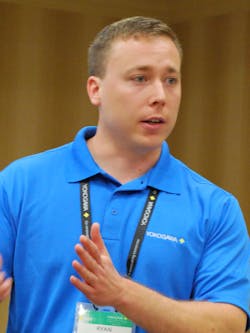While the control of industrial process heaters has come a long way since excess oxygen in flue gases was first measured in the 1920s—at 15-minute intervals!—common industry practice still lags what’s now possible, according to Ryan McSherry, Yokogawa product manager for laser analyzers and gas chromatographs. Indeed, modern analyzer technology can dramatically increase the safety and control of the thousands of fired heaters in use across industry today, McSherry said to attendees of the Yokogawa Users Group conference this week in Orlando.
“The zirconia oxygen sensor and thick-film combustibles sensor are the baseline of what’s been done for the past 25 years,” noted Don Wyatt, director of business development for TechStar, a Houston-based specialist in process instrumentation and analytical systems. “There is now a step-change available that makes it so much better.”
"Many of today’s heaters rely on pretty simplistic control for dynamics that are actually quite complex.” Yokogawa's Ryan McSherry discussed the advantages of laser spectrometers for improved control and safety of industrial combustion processes.
Indeed, the Tunable Diode Laser Spectrometers (TDLS) that Wyatt referenced (and for which McSherry is responsible) cost more than traditional instrumentation. But a growing number of industry practitioners are finding that TDLS overcomes important limitations of the traditional approach, McSherry said, citing sections of relevant codes and standards from the National Fire Protection Association (NFPA) and American Petroleum Institutes (API) that give a nod to the advantages of laser spectroscopic technologies.By way of background, the accurate measurement of both oxygen and carbon monoxides and other combustibles in flue gas is important if excess oxygen is to be controlled at an optimal level in order to provide both high energy efficiency and complete fuel combustion. Run too rich, and end up with carbon monoxide and uncombusted fuel. Run too lean, and form nitrogen oxides. Further, the accurate measurement of carbon monoxide and other combustibles in off-gas is an important early indicator of fuel-rich conditions. Complicating matters even more are fuels that vary in BTU content—paired with volumetric fuel flow measurement devices—as well as sensor technologies that can mistake high combustibles for high excess oxygen then drive the system to flame-out. “Many of today’s heaters rely on pretty simplistic control for dynamics that are actually quite complex,” McSherry said.
But perhaps the most compelling argument against zirconia probes is that they must be heated to operate properly, effectively creating an in-process “spark plug” for any residual hydrocarbons. That means that the oxygen sensor is turned off during heater purging and start-up—just when visibility is most needed. Laser spectrometers aren’t heated, and provide selective, drift-free measurement of flue-gas components during all phases of operation. “Now I’m not blind anymore,” Wyatt said. “I’m able to make measurements at start up when I most need them.”
More information on how you can improve the energy efficiency, safety and compliance of your plant’s fired heaters is available in a comprehensive new Yokogawa e-book entitled “Combustion & Fired Heaters: An Analytical Approach to Improving Safety & Efficiency.” Download your free copy here.
[sidebar id =2]
About the Author
Keith Larson
Group Publisher
Keith Larson is group publisher responsible for Endeavor Business Media's Industrial Processing group, including Automation World, Chemical Processing, Control, Control Design, Food Processing, Pharma Manufacturing, Plastics Machinery & Manufacturing, Processing and The Journal.

Leaders relevant to this article:



